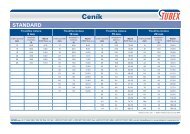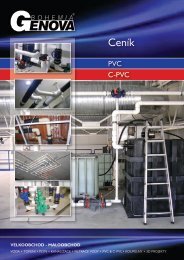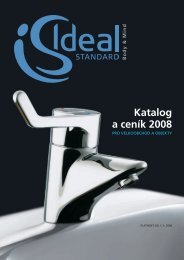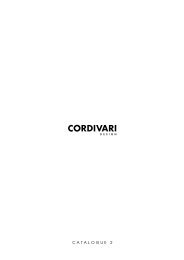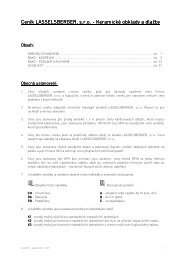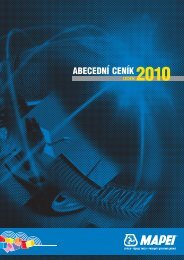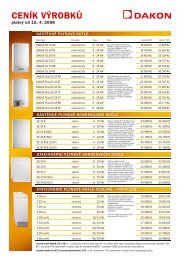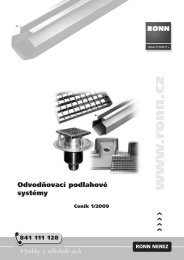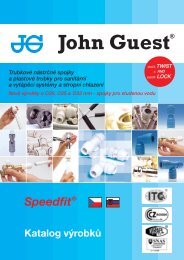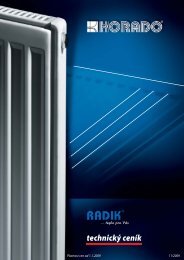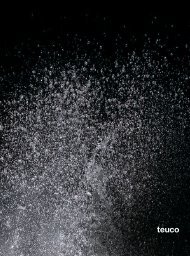You also want an ePaper? Increase the reach of your titles
YUMPU automatically turns print PDFs into web optimized ePapers that Google loves.
98<br />
Iformación Técnica<br />
Características Técnicas · Technical characteristics<br />
PAVImENTo/FLooR<br />
TILES<br />
ISo10545-6<br />
RESISTENCIA A LA<br />
ABRASIoN<br />
ABRASIoN RESISTANCE<br />
EN 67-101-92<br />
DUREZA AL RAYADo<br />
moHS SCRATCH<br />
HARDNESS<br />
ISo 10545-4<br />
RESISTENCIA A LAS mANCHAS<br />
RESISTANCE To STAINS<br />
ISo 10545-13<br />
REISISTENCIA QUImICA<br />
CHImICAL RESISTANCE<br />
ISo 10545-12<br />
RESISTENCIA A LA HELADA<br />
FRoST RESISTANCE<br />
ISo 10545-3<br />
ABSoRCIoN DE AGUA<br />
WATER ABSoRTIoN<br />
Arizona 5 9 GHA GA-GLA I<br />
Borneo(Cognac,roble,wengué) 3 6 GHA GA-GLA Resiste II a<br />
Borneo haya 4 6 GHA GA-GLA II a<br />
Casual 4 6 GHA GA-GLA II a<br />
Comfort 4 6 GHA GA-GLA II a<br />
Compact 5 9 GHA GA-GLA Resiste I<br />
Dakota 5 9 GHA GA-GLA Resiste I<br />
Dorset haya 4 6 GHA GA-GLA II a<br />
Dorset (caoba, roble)<br />
Futura (azul, rojo, verde,<br />
negro, naranja)<br />
3<br />
3<br />
6<br />
6<br />
GHA<br />
GHA<br />
GA-GLA<br />
GA-GLA<br />
IIa IIa Futura blanco 4 6 GHA GA-GLA IIa Gante 4 6 GHA GA-GLA II a<br />
Jamaica 4 5 GHA GA-GLA II a<br />
kalos 5 9 GHA GA-GLA Resiste I<br />
Kavir 5 8 GHA GA-GLA II a<br />
Leonardo 4 6 GHA GA-GLA II a<br />
madison (beige, marfil) 4 6 GHA GA-GLA II a<br />
madison pizarra 3 6 GHA GA-GLA II a<br />
majestic 4 6 GHA GA-GLA II a<br />
millenium 4 6 GHA GA-GLA II a<br />
mittal<br />
oregon (cacao, roble,<br />
peach, azul)<br />
4<br />
3<br />
6<br />
6<br />
GHA<br />
GHA<br />
GA-GLA<br />
GA-GLA<br />
IIa IIa oregon blanco 4 6 GHA GA-GLA IIa Paris 3 6 GHA GA-GLA II a<br />
Piedra 5 9 GHA GA-GLA Resiste I<br />
Portland 4 6 GHA GA-GLA II a<br />
Sidon 4 5 GHA GA-GLA II a<br />
Stratos blanco 3 6 GHA GA-GLA II a<br />
Stratos (cobre, negro) 2 6 GHA GA-GLA II a<br />
Toscano 4 6 GHA GA-GLA II a<br />
Grupo I E < 3 %<br />
Grupo II a 3% < E < 6 %<br />
CoLoCACIÓN DE PAVImENToS EN EL EXTERIoR<br />
Los pavimentos cerámicos para exteriores están siempre sometidos a condiciones atmosféricas adversas, que pueden provocar<br />
daños irremediables a cualquier material que se utilice. Son perjudiciales en particular la humedad, el hielo, los rápidos y bruscos<br />
cambios de temperatura con fuertes dilataciones y contracciones.Por lo tanto, es indispensable que para cada aplicación en exterior,<br />
las obras de albañilería se realicen con los oportunos conocimientos de los problemas técnicos inherentes e indispensables para<br />
una mayor durabilidad. En particular, son esenciales las pendientes, las impermeabilizaciones, las juntas de dilatación, los materiales<br />
para el asiento, ...<br />
PENDIENTES E ImPERmEABILIZACIÓN<br />
No existe ningún pavimento exento absolutamente de infiltraciones de humedad. Por lo tanto, es básico aislar la obra de mampostería<br />
bajo el pavimento, de forma que se evite, en caso de infiltraciones húmedas a través de las juntas, la formación de<br />
rebalsas bajo el pavimento, porque en caso de hielo, el resultado sería el alzamiento de las baldosas o la posible aparición de<br />
fracturas de tipo concoideo. Además, rebalsas prolongadas en contacto con morteros y hormigones conducen a la formación de<br />
sales complejas seguidas por fuertes aumentos de volumen. La elevada presión resultante provoca la subida en superficie por<br />
capilaridad de las sales, formación de manchas, y despegos violentos del esmalte de los azulejos asentados. Evidentemente, una<br />
colocación realizada utilizando los adhesivos específicos para exteriores, está en condiciones de evitar la gran mayoría de estos<br />
inconvenientes, pero en los casos donde no haya impermeabilización, el agua filtrada bajo el pavimento ocasionará graves daños.<br />
Los responsables de las obras tendrán, por lo tanto, que prever las oportunas pendientes, a fin de garantizar que el paso del agua<br />
bajo el pavimento se desvíe hacia el exterior, evitando rebalsas. De este modo, será conveniente la impermeabilización con los<br />
materiales adecuados.<br />
Novogres S. A. no se responsabiliza de los daños sufridos en colocaciones realizadas con morteros o soluciones tradicionales, o<br />
aquellas que se realicen con productos que no sean específicos para condiciones climatológicas extremas. En estos casos, es decir,<br />
en condiciones de climatología adversa, recomendamos dirigirse a un profesional de colocación especializado, que siga perfectamente<br />
todas las pautas de uso y de colocación de material en el exterior.<br />
NoRmAS DE LImPIEZA Y mANTENImIENTo:<br />
Después de la colocación es fundamental realizar una buena limpieza para eliminar residuos de junta y en general suciedad de la<br />
obra.<br />
Es aconsejable el empleo de un detergente de acción ligeramente ácida que no despida humos tóxicos y respete las juntas, el<br />
material y el usuario, como Fila Deterdek.<br />
Para un buen mantenimiento del pavimento se aconseja el empleo de un detergente neutro de alto poder limpiador como Fila<br />
Cleaner. En los casos de suciedad orgánica intensa y acumulada en el tiempo, grasas, etc., se aconseja la utilización extraordinaria<br />
de un detergente de tipo desengrasante como el Fila PS/87.<br />
HYPERLINK “http://www.filachim.com” www.filachim.com<br />
FILA INDUSTRIA QUÍmICA S.L. CTRA. N-340, Km. 948 - 12592 Chilches (Castellón) Tel: 964 590101 Fax: 964 583265<br />
Iformación Técnica 99<br />
Recomendaciones de Colocación · Technical characteristics<br />
Coordinados · Coordinated wall and floor tiles<br />
Pavimento · Floor tile<br />
Revestimiento · Wall tile<br />
Pasta blanca · White body<br />
INSTALLATIoN oF EXTERIoR FLooR TILES<br />
Floor ceramic tiles in exterior areas will be subject to adverse atmospheric conditions, that could cause irreparable damage. In particular<br />
those such as humidity, ice or quick changes of temperature, that will produce extreme expansion and contraction of the area.<br />
Therefore, it is indispensable that for each exterior installation, the correct setting materials and knowledge of the technical difficulties<br />
involving this type of work, be known to guarantee the durability of the final result. Elements such as correct slopes, waterproofing<br />
methods and expansion joints are fundamental.<br />
SLoPES AND WATERPRooFING<br />
No laid flooring may be considered to be completely free from moisture infiltrations. It is therefore of fundamental importance, to<br />
prepare the floor foundation to so, to prevent the formation of harmful pockets of water under the floor in the event of moisture<br />
infiltrations through the joints. In the event of frost, these would lift the tiles on top, or even would cause the appearance of under<br />
glaze shell-like cracking. In addition, prolonged water accumulation in contact with mortar and concrete, could cause the formation of<br />
salt deposits.<br />
As a result, a higher pressure will produce the effect known as “efflorescence”, in which accumulated mineral salt concentrations raise<br />
to the surface of the tile, originate spots and lift of the glazed surface. By always using setting materials specifically designed for<br />
exterior ceramic tile installations, we will avoid the majority of problems associated with this type of setting. If waterproofing, such as<br />
the use of membranes, is not performed, water that gets under the tile will cause significant damages.<br />
Contractors and installers will have to create inclines in order to facilitate water flow under the tiles and diverting it towards the exterior.<br />
This will avoid water accumulation under the installation. It is recommended to use waterproofing materials for exterior installations.<br />
Novogres S.A. is not responsible for damages caused by installations performed with traditional mortars, or setting materials not<br />
recommended for exterior installations subject to severe weather conditions. For this type of installation, we recommend it to be<br />
done by a certified professional installer that will follow all norms and required steps to accomplish a good installation of ceramic tile<br />
for outside areas.<br />
CLEANING AND PRESERVATIoN NoRmS:<br />
It is essential after the tiling to effects a deep cleaning of the surface to eliminate any solid waste of adhesive cement or joint<br />
material.<br />
It is advisable to use an acid washing detergent, such as Fila Deterdek, which do not emit any toxic fumes and do not damage the<br />
surface and the joints.<br />
For the good maintenanceof the floor tile we advise to use a neutral and powerful cleaner detergent as Fila Cleaner. In particular<br />
case of a heavy organic dirt or intense greasy surface, we do recommend an extraordinary washing detergent as Fila PS187 wich<br />
remove the grease immediately.<br />
HYPERLINK “http://www.filachim.com” www.filachim.com<br />
FILA INDUSTRIA QUÍmICA S.L. CTRA. N-340, Km. 948 - 12592 Chilches (Castellón) Tel: 964 590101 Fax: 964 583265<br />
Simbología · Symbols<br />
Pasta roja · Red body<br />
Pasta coloreada · Coloured body<br />
Exterior · outdoor floor tiles<br />
Antideslizante · Antislip<br />
Agradecimientos a fabricantes de muebles de baño, sanitarios y cocinas: INBANI, TABERNER, NAXANI, UNISAN, moYEX



